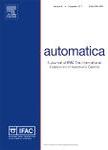版权所有:内蒙古大学图书馆 技术提供:维普资讯• 智图
内蒙古自治区呼和浩特市赛罕区大学西街235号 邮编: 010021

作者机构:Bosch Ctr Artificial Intelligence Renningen Germany Univ Padua Dept Informat Engn Padua Italy ETH Inst Dynam Syst & Control Zurich Switzerland
出 版 物:《AUTOMATICA》 (自动学)
年 卷 期:2020年第118卷
页 面:109032-109032页
核心收录:
学科分类:0711[理学-系统科学] 0808[工学-电气工程] 07[理学] 08[工学] 070105[理学-运筹学与控制论] 081101[工学-控制理论与控制工程] 0811[工学-控制科学与工程] 0701[理学-数学] 071101[理学-系统理论]
基 金:University of Padova Italy Progetto di Ateneo [CPDA147754/14]
主 题:Spatio-temporal Gaussian processes Kalman filter Machine learning Representer theorem Separable kernel functions
摘 要:We study the non-parametric reconstruction of spatio-temporal dynamical processes via Gaussian Processes (GPs) regression from sparse and noisy data. GPs have been mainly applied to spatial regression where they represent one of the most powerful estimation approaches also thanks to their universal representing properties. Their extension to dynamical processes has been instead elusive so far since classical implementations lead to unscalable algorithms or require some sort of approximation. We propose a novel procedure to address this problem by coupling GPs regression and Kalman filtering. In particular, assuming space/time separability of the covariance (kernel) of the process and rational time spectrum, we build a finite-dimensional discrete-time state-space process representation amenable to Kalman filtering. With sampling over a finite set of fixed spatial locations, our major finding is that the current Kalman filter state represents a sufficient statistic to compute the minimum variance estimate of the process at any future time over the entire spatial domain. In machine learning, a representer theorem states that an important class of infinite-dimensional variational problems admits a computable and finite-dimensional exact solution. In view of this, our result can be interpreted as a novel Dynamic Representer Theorem for GPs. We then extend the study to situations where the spatial input locations set varies over time. The proposed algorithms are tested on both synthetic and real field data, providing comparisons with standard GP and truncated GP regression techniques. (C) 2020 Elsevier Ltd. All rights reserved.